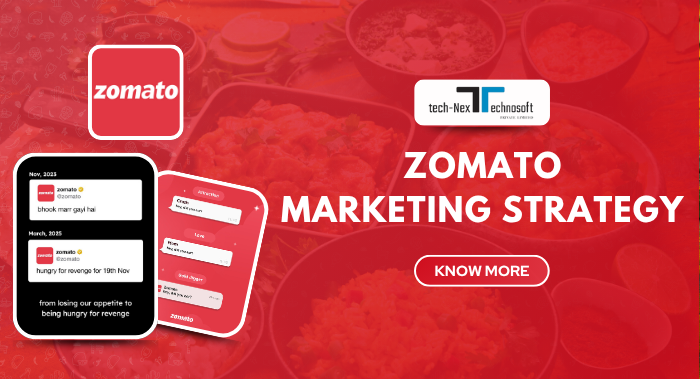Welcome To Technext Technosoft
OUR THOUGHTS

Zomato’s Marketing Strategy: Changing the Indian Online Food Delivery Landscape
02/07/2025
Just imagine it's a lazy Sunday, and you're craving a tasty biryani. So, instead of ignoring the craving, you grab your phone, open the Zomato app, order your favourite food, and within minutes, your food is at the door. But why only Zomato? The answer lies in the smart Zomato marketing strategy.
Zomato has constantly remained ahead of its competitors by adopting innovations such as AI-powered improvements, grocery delivery, and cloud kitchens. This case study dives into what made Zomato unique, how its marketing strategy worked, and how it has transformed the food delivery app in India.

Zomato’s Brand Introduction
Zomato, founded in 2008 by Pankaj Chaddah and Deepinder Goyal, is a major player in India’s digital food space. It started as a directory for restaurant menus and reviews. Zomato has evolved into a comprehensive digital food delivery service, leveraging the rise of smartphone usage to offer food delivery, grocery access, and even table reservations. Zomato marketing strategy has helped the brand expand to over 20 countries. The application features a flawless ordering process, AI-backed recommendations, and various partner networks, making Zomato a discovery in online food ordering trends.
Marketing Analysis Of Zomato
Know why Zomato is the top-most application in the food delivery game by exploring strengths, weaknesses, opportunities, and threats through a quick SWOT analysis. Know what makes Zomato stand out:
- Strengths – An essential element of Zomato's marketing strategy is its vast network of delivery agents and restaurant partners. Zomato's intuitive interface, pro membership, and customized experiences enhance customer loyalty.
- Weaknesses - Heavy dependency on discounts impacts Zomato’s profit margins. While the strategy helps attract users, it creates challenges in user retention without offers. There are also logistical concerns in rural areas where digital infrastructure and reliable delivery are still developing.
- Opportunities – The Zomato marketing strategy has room to grow in tier-2 and tier-3 cities where smartphone penetration is rising. It can also enter niche markets by promoting eco-friendly packaging and sustainable practices.
- Threats - Competition from Swiggy, ONDC, and Domino’s continues to rise. Zomato must also navigate regulatory changes and the growing shift toward homemade and healthy eating. The adaptable Zomato marketing strategy positions the brand to handle such external pressures effectively.
Competitive Landscape Of Zomato
Swiggy uses hyperlocal delivery, strategic influencer tie-ups, and rewards-based campaigns to maintain engagement. Unique services like Swiggy Genie and Instamart reinforce their brand.
Domino’s leverages its app, loyalty programs, and strong offline campaigns to dominate the pizza segment. They offer consistent service with minimal reliance on aggregators.
Uber Eats, before exiting India, promoted bundled offers between ride-hailing and food delivery. It emphasized personalized experiences, showing that international players need localized strategies in India’s diverse market.
Zomato’s Target Audience
The Zomato marketing strategy primarily targets urban users aged 18 to 34, especially the 25–34 age group, who value convenience and quick solutions. These digital-savvy individuals often juggle work, study, or urban living and appreciate value-for-money services.
Zomato also appeals to casual eaters and foodies by offering everything from budget meals to gourmet options. This demographic alignment makes Zomato one of the most relevant digital food delivery services in India.
Key Elements of Zomato Marketing Strategy
The Zomato marketing strategy focuses on creating a seamless, data-driven, and engaging experience for users. There are the key elements that make this strategy so powerful:
- Restaurant Listings & Promotions – Zomato generates revenue by allowing restaurants to pay for higher search visibility. The platform uses customer data to match users with promoted listings that suit their tastes, enhancing click-through and conversion rates.
- Delivery Charges - A part of the Zomato marketing strategy involves earning from delivery fees and commissions on each order. These profits are shared with restaurants and delivery partners, promoting a win-win ecosystem while driving faster fulfillment.
- Loyalty Program – Zomato Pro (formerly Zomato Gold) offers exclusive discounts and partner benefits. This loyalty model promotes repeat business and customer retention. The Zomato marketing strategy ensures that value-added updates keep members subscribed.
- Events & Jomaland - Zomato-hosted festivals, such as Jomaland, create direct community engagement. These events not only build emotional branding but also generate extra income through ticketing and merchandise, making them a strong pillar of the Zomato marketing strategy.
- Consulting & Hyperpure – Zomato supports new restaurant partners with data consulting and Hyperpure, a supply service offering premium ingredients. This end-to-end control ensures food quality, helping Zomato stand out in the online food ordering trends ecosystem.
Digital Marketing Strategy of Zomato
Zomato’s digital marketing is smart, witty, and highly engaging. By blending humor, data, and user behavior insights, Zomato has built a strong online presence that keeps users coming back. Here is how Zomato leads the digital game:
- SEO Strategy - Zomato leads in SEO by targeting high-search-volume keywords like “best restaurants near me” and “order food online.” Localized, seasonal, and mobile-optimized content ensures a strong ranking. As a result, the site receives 20.4 million monthly visits and ranks for over 4.8 million backlinks. More than 54% of traffic is organic, proving the SEO arm of the Zomato marketing strategy is both robust and effective.
- Social Media Marketing - Zomato’s witty Twitter banter, engaging Instagram posts, and storytelling on Facebook play a crucial role in brand recall. Whether through food memes or viral customer interactions, their humorous and relatable approach deepens engagement. This social media playbook, a major part of the Zomato marketing strategy, drives user interaction and positions Zomato as a trend-savvy brand that understands its audience.
To Sum It Up
The Zomato marketing strategy blends with customer insight, innovation, and adaptability to maintain good leadership quality in the food tech space of India. Zomato remains a benchmark for marketing excellence, from SEO and app UX to loyalty programs and event marketing. As user behaviors and industry dynamics shift, the Zomato marketing strategy continues to evolve, balancing fun with function. Zomato shows how the right mix of tech and creativity can redefine food delivery in India.
